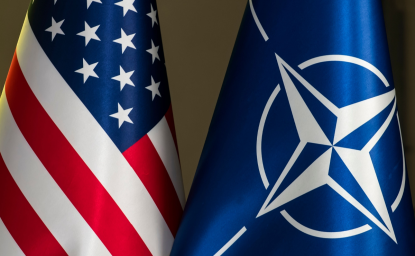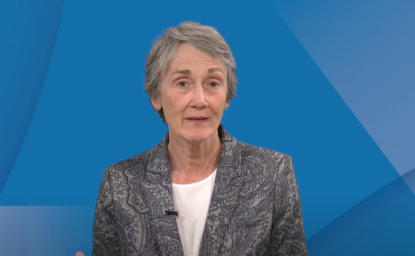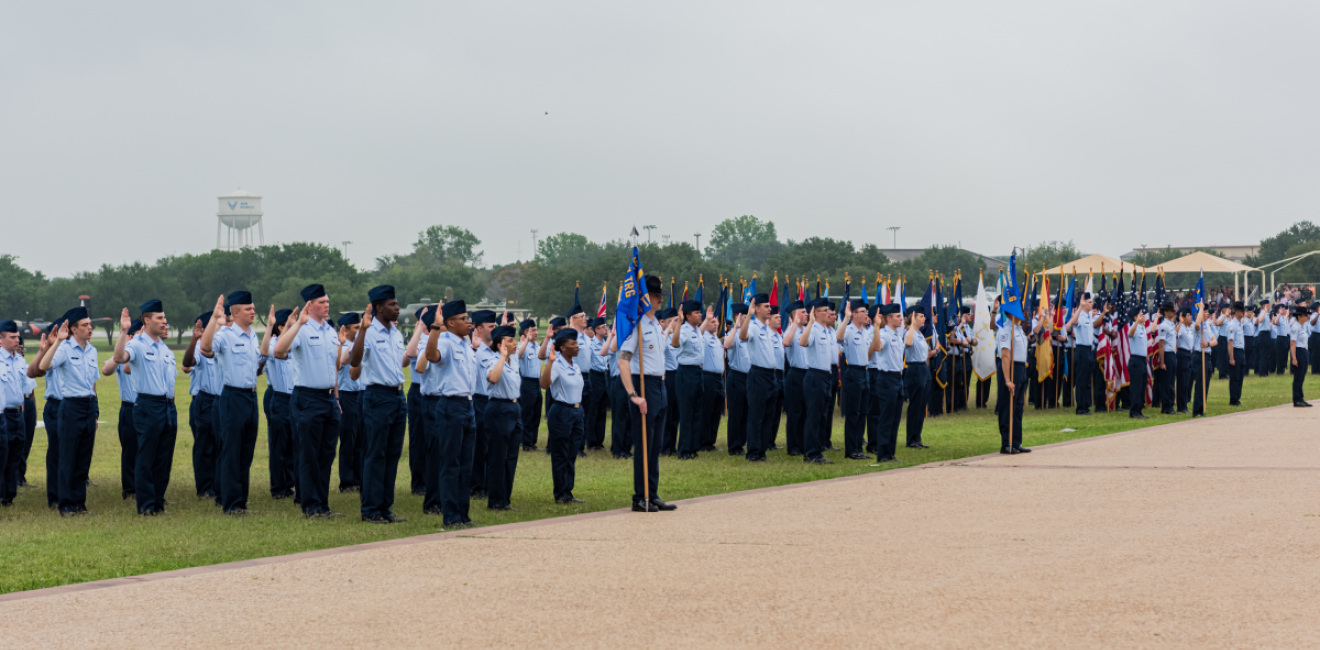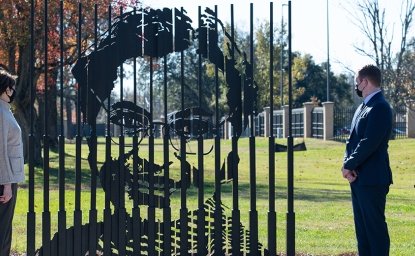In today’s geopolitical strategic competition, a country needs not only the most advanced technology, but the talent to effectively employ it. Indeed, technology magnifies the importance of talent that can effectively harness its benefits. Without such talent, the latest technology is of limited value. While true in all human endeavors, it is essential in the military, where an individual’s decisions can have real-world life or death consequences.
The Wilson Center this year had the privilege of hosting Colonel Michelle Sterling as a US Air Force Fellow. Colonel Sterling’s experiences include being a squadron commander for the Basic Military Training course that forms the “initial coat of paint” in developing the Air Force’s human infrastructure. Michelle believes such training must help develop an “expert craftsman with the absorptive capacity to learn and apply that learning to novel contexts, the adaptive capacity to respond effectively in dynamic environments, and the decision-making capacity to be decisive while retaining relationships within our values.” The subset of her recommendations to achieve this goal outlined below apply not just to the military, but to all seeking to cultivate the talent they will need for a future that is being disrupted by profound technological advances.
—Mark Kennedy
The Airmen We Need — Resilient Warriors of Character
If personality is how you respond on a typical day, character is how you show up on a hard day.
—Adam Grant
Even as a tsunami of emerging technologies change the character of war, its nature endures. With it comes the risk of neglecting that most precious of commodities—the humans who put technology to its highest and best use. The latest shiny objects such as artificial intelligence may change how we engage in conflict and war, but humans will always remain at the center. People matter. Character matters. As the U.S. Air Force “Reoptimizes for Great Power Competition” (GPC), the morals and ethics of the people who prosecute wars will become more, not less consequential as the technology they employ evolves.
In Masters of the Air, Donald Miller recounts how early aerial warfare practitioners were obsessed with minimizing the human toll of war through the air. “Prewar strategists foresaw the bomber war as a battle of machines against machines, with little human contact.” Despite their desire to minimize the human toll, flawed assumptions meant that before the war ended, the Eighth Air Force’s casualties would exceed those of Marines in the Pacific Theater. In 1948, after these enormous wartime losses, the Air Force published its first leadership manual which included a cautionary note:
“…future warfare, however automatic, will necessitate more intelligence, skill, courage, and responsibility by the men using the weapons than was ever necessary in the past. Only sound leadership will insure (sic) that air force units will successfully accomplish their tasks.”
These same airpower strategists now realized what mattered most were the humans employing the technology and not the technology itself.
Research demonstrates that character skills such as being proactive, (taking initiative), prosocial (collaborative, able to get along with others), disciplined (attention and self-regulation), and determined (persevere in the face of obstacles, grit, resilience) are highly correlated with life success. It’s no coincidence we adopted them as part of our Air Force Foundational Competencies -- they are our aspirational character as Airmen. “Character is [our] capacity to prioritize [our] values over [our] instincts…. How [we] show up on a hard day.” War is replete with hard days. So is training for war. Yet our evaluations focus on technical competence, with wide variation in how the Air Force evaluates character and holds Airmen accountable for it. We must invest in developing character alongside our efforts to build new operational approaches with collaborative combat aircraft, mission ready Airmen, and distributed operations under agile combat employment. We need to focus on developing what I call Resilient Warrior Airmen of Character.
Beginnings matter.
My beginning in the Air Force shaped my perspective of what unit mission readiness means – and it rhymed with the future Combat Wing structure. Immediately after arriving at my first duty station (in the Pacific), I was immersed in a robust training and exercise cycle built around Korean Peninsula war plans. Even after the terrorist attacks of September 11, 2001, we remained focused on training to “survive and operate” in a denied environment under attack. As the U.S.-led coalition launched Operation Iraqi Freedom in 2003, our wing remained focused on proving we could credibly mobilize, deploy, and fight our assigned Operations Plan as an integrated team. Then, amid our Operational Readiness Inspection, we received orders to deploy to an Air Expeditionary Wing at Balad Air Base in Iraq. Despite the vast differences in the environment and the adversary, we were ready. To develop the Gen Z recruits into the Resilient Warrior Airmen of Character we need for the future fight requires the military to provide different support and scaffolding based on three complementary human capital concepts: 1) growth mindsets; 2) psychological safety to support learning and innovation; and 3) the power of defining moments to galvanize teams and forge organizational commitment.
Growth mindset.
A growth mindset is the “belief that a person’s true potential is unknown and unknowable,” that learning requires failing with good intent, and traits such as intelligence and talent aren’t static. “Growth-minded leaders…start with a belief in human potential and development.” Yet, the competitive nature of evaluations, stratifications, and promotions leads to its opposite: a risk-averse fixed mindset. “…[I]nstead of learning, growing, and moving the company forward, everyone starts worrying about being judged.” and falling short. They become ‘nonlearners’ Instead, we must foster a culture of mission command populated with learners who speak up and take risks in pursuit of innovation. The not-so-secret ingredient for growth minded individuals and organizations? Psychological safety.
Psychological safety.
Psychological safety manifests as a group-level “belief that the work environment is safe for interpersonal risk-taking.” It strongly correlates to a group’s willingness to “engage in learning behaviors, such as information sharing, asking for help, or experimenting.” Those learning behaviors can be achieved through a commitment to candor, transparency, learning from error; a willingness to root out poisonous, entrenched organizational norms; and devotion to maintaining high performance standards. When paired with high standards, psychological safety builds cohesive, operationally effective teams and increases the likelihood we can reduce unwanted failure while harnessing intelligent failure to create new knowledge. This is not a call to consider all failure as productive and noble. Military operations have inherent risk to life and property. Carelessness can and has caused many tragic losses of life during peacetime and training operations. Therefore understanding the situation and type of failure is critical to maintaining psychological safety as we train and adapt new technologies for use in GPC. Only a small percentage of failures can truly be considered blameworthy, yet many leaders treat all failures that way. In reality, most errors are unintended. Punishing failures from unintended errors as if they were blameworthy fails as a prevention strategy because it encourages hiding errors instead of fixing them. Hidden failures cannot be corrected, but they can compound.
Defining moments.
The Air Force is obsessed with data, metrics, and goals. Airmen – the humans who are the Air Force – remember and cherish moments, because moments become their story. The good news is that our culture and heritage offer many opportunities to create stories of elevation, insight, pride, and connection to their comrades, their unit, the Air Force, and the nation. Each new assignment, promotion, deployment, awards presentation is a chance to build shared narratives forging connections between people and ideas which convey our culture, history, and values. Defining moments create shared narratives forging connections between people and ideas which convey our culture, history, and values. .
In this time of significant structural and strategic change, an Airman’s initial experience is a crucial step on a path of shared values, organizational commitment, and true understanding of what it means to be an Airman. This includes deliberately creating peak experiences to viscerally mark the shift from “old way” to “new way” and to connect people to the way forward. It begins at Air Force Basic Training. It must continue through the first operational assignment because how people start matters. It shapes our stories. As we aim for effectiveness, we must “beware the soul-sucking force of reasonableness…speed bumps are reasonable. Mount Everest is not reasonable.” But people build their lives around Mount Everest.
Our Airmen are our most valuable asset. As the Air Force re-optimizes for Great Power Competition, cultivating their growth mindset, ensuring psychological safety and shared experiences must be among our top priorities. A laser focus on that cultivation within our efforts to Develop People will ensure we develop mission-ready Resilient Warrior Airmen of Character—The stakes are high. And the time is now.
The views expressed are those of the authors and do not reflect the official views of the United States Air Force, nor the Department of Defense. Mention of trade names, commercial products, or organizations do not imply endorsement by the U.S. Government, and the appearance of external hyperlinks does not constitute DoD endorsement of the linked websites, or the information, products or services therein.
Author
Colonel, United States Air Force
Contributor


Wahba Institute for Strategic Competition
The Wahba Institute for Strategic Competition works to shape conversations and inspire meaningful action to strengthen technology, trade, infrastructure, and energy as part of American economic and global leadership that benefits the nation and the world. Read more

Explore More
Browse Insights & Analysis
A Dangerous World Needs a Stronger US-Led NATO

University of Texas at El Paso President Heather Wilson on 'What Is Strategic Competition?'


